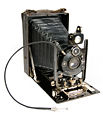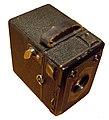Optical institute CP Goerz
The Optische Anstalt CP Goerz was a company in Berlin that specialized in the manufacture of optical lenses and cameras .
history

Carl Paul Goerz founded a mail order business for mathematical instruments in Berlin in 1886, which also supplied photographic equipment from 1887. The economic success allowed Goerz to take over the workshop of F. A. Hintze in 1888 and as C. P. Goerz, Spezialfabrik photograph. Amateur cameras to produce their own cameras. After the production of lenses began, the company was renamed the Optical Institute C. P. Goerz in 1890 . The company's headquarters were in Hauptstrasse 7a, Schöneberg (from 1920: Berlin-Schöneberg ).
In 1889 Goerz learned about the invention of the focal plane shutter , then known as the moment shutter , by the photographer Ottomar Anschütz . With this invention, exposure times of 1 ⁄ 1000 seconds were achieved, making photography of moving objects possible for the first time. Goerz acquired the right to manufacture alone and with the Goerz-Anschütz-Moment-Camera offered the first focal plane shutter camera in the world. The company quickly became well known.
| year | produced lenses |
|---|---|
| until 1891 | 4,000 |
| until 1896 | 30,000 |
| until 1901 | 100,000 |
| until 1911 | 300,000 |
With this attitude of the optician Emil von Höegh , lens construction at Goerz took off enormously. Von Höegh built a high quality double anastigmate which was successfully marketed under the name Dagor . The license for Great Britain was given in 1893 to the company Ross & Co. in London , that for Austria-Hungary to Karl Fritsch in Vienna . In 1900 the Goerz-Hypergon followed , an anastigmatic wide-angle lens with an image field of 135 °. The company's reputation also increased thanks to special productions, for example for the animal photographer Carl Georg Schillings or the photochemist Adolf Miethe , according to whose plans a three-color projector was manufactured.
Goerz received the first orders for the manufacture of military optics as early as 1891. The company became a supplier to the imperial army and naval offices as well as to many foreign military administrations. From 1897 lens telescopes were manufactured in large numbers. In 1899 Goerz took over the representation of Barr and Stroud for the distribution of optical rangefinders in the German Reich . In 1903 a special military department was founded and subsequently rangefinders, submarine periscopes , scissor telescopes and aiming devices for guns were produced. The optical institute CP Goerz became the world's largest manufacturer of military optics.
| year | Employees |
|---|---|
| 1889 | 25th |
| 1891 | 40 |
| 1897 | 300 |
| 1908/09 | 1370 |
| 1911 | 2500 |
The entrepreneurial success led in 1903 to the transformation of the company into a stock corporation with a share capital of 3.5 million marks , the optical institute CP Goerz AG, Berlin-Friedenau at Rheinstrasse 45/46 ( rural community Friedenau , from 1920: Schöneberg district ). In 1911 the number of employees had grown to 2,500. The company included not only the optical and mechanical workshops, but also a tool shop, a blacksmith's shop, an engraving shop, a saddlery, a paint shop and several workshops for the manufacture of camera housings. Sales branches abroad had already been opened in the 1890s, for example in Paris in 1893 , in New York in 1895 and in London in 1899. The first branch was established in New York in 1902. It was followed by branches in Saint Petersburg (1905) and Pressburg (1908).
From 1898 Goerz had his own design office for the mechanical parts of the instruments. In 1909 a department for meteorological and aeronautical equipment was set up, the scientific management of which was taken over by the meteorologist and balloonist Arthur Berson in 1910 . In 1911, the first astronomical instrument to be manufactured was a reflecting telescope for the Technical University of Charlottenburg . Another reflector telescope is now in the observatory of the Deutsches Museum in Munich . The device was specially built for the expedition led by Adolf Miethe to Sandnessjøen in Norway to observe the solar eclipse of August 21, 1914 .
In 1910 an interest group was formed with the stock corporation Hahn for optics and mechanics, Ihringshausen / Cassel , in which the optical institute CP Goerz was in charge. In the mid-1920s, the profile cylinder was developed at Hahn , which later became a mainstay of sales for Zeiss Ikon AG . With the acquisition of the Sendlinger Optische Glaswerke , founded by Joseph von Fraunhofer and Carl August von Steinheil , Goerz made himself independent of suppliers from the glass industry. The factory in Munich- Sendling was extensively modernized, but then relocated to Schönow ( Zehlendorf ) during the First World War , where a production facility was set up in Goerzallee 271 next to the new “Goerzwerk”. Headlight production from Körting & Mathiesen in Leipzig-Leutzsch was taken over during the Second World War . Mainly arc lamps with Fresnel lenses for lighthouses were built here.
During the First World War, Goerz produced almost exclusively optical equipment for the military with around 12,000 employees. This brought the company into great financial difficulties after the end of the war, as the Versailles Treaty banned German companies from producing for military purposes. Goerz tried to convert the product range to civilian products such as calculating machines and saccharimeters . The merger with other companies in the photo-optical industry to form Zeiss Ikon AG in 1926 meant the rescue of the company that would otherwise have gone bankrupt . In the Goerzwerk Berlin-Zehlendorf , Goerzallee 299, the TV AG founded in 1929 (from October 1939: Fernseh GmbH ) had its headquarters. The American branch existed as CP Goerz American Optical Company until 1972 when it was operated by Schneider Optics , the American subsidiary of Jos. Schneider Optische Werke was taken over.
With the formation of Zeiss Ikon AG , the production profile of Goerz was changed and the production of optical articles was almost completely abandoned in favor of the 53% majority stake of Zeiss-Werke in Jena . Cameras and lighting devices for cinema projectors and profile cylinders were now being produced in Berlin.
Box Tengor II 56/2 6 × 9 Goerz Frontar-Achromat 9/110 produced from 1948 to 1956
Awards
- A gold medal for excellent lenses at the world exhibition in Antwerp in 1894.
- 1899 an honorary diploma (April 1 to May 31, Societa fotografica Italiana) in Florence,
- a gold medal and certificate of honor in Stuttgart and
- a gold medal in Baden-Baden.
literature
To the company
- Festschrift Published by the optical institute C. P. Goerz Akt.-Ges. Berlin Friedenau on the occasion of the celebration of its 25th anniversary 1886–1911 . 105 p., Numerous Fig .; contains u. a. a detailed product history.
- Conrad Matschoss: men of technology. A biographical manual published on behalf of the Association of German Engineers . Springer, Berlin 1925, p. 91 f (PDF; 1.8 MB).
- Jörg Zaun: Instruments for Science. Innovations in Berlin precision mechanics and optics 1871–1914 . Publishing house for science and regional history, Berlin 2002, ISBN 3-929134-39-X .
- Richard Hummel: SLR cameras from Dresden. History, technology, facts. Lindemanns, Stuttgart 1998, ISBN 3-89506-127-1 .
- Richard Neuhauss : The optical institute C. P. Goerz in Berlin-Friedenau . In: Photographische Rundschau 13, 1899, pp. 129–137.
- [without name]: Visit to the optical facility of C. P. Goerz in Berlin . In: Photographische Rundschau 5, 1891, pp. 337–338.
To the products
- [no name]: C. P. Goerz's new photographic double lens . In: Photographische Rundschau 7, 1893, pp. 235–238.
- R. Sch .: Momentary handset "Reporter" . In Charles Scolik (ed.): Photographische Rundschau 3, Wilhelm Knapp, Halle / S., 1890, pp. 265–269.
- Goerz camera according to Anschütz . in: Photographische Mitteilungen , 29th vol., Berlin 1892/93, pp. 132-133
Web links
- Literature by and about Optical Institute CP Goerz in the catalog of the German National Library
Individual evidence
- ↑ Goerz . In: Berliner Adreßbuch , 1890, part 1, p. 349.83965
- ↑ Between 1897 and 1916 today's industrial complex was built in several construction phases ; The architects were Paul Egeling , Waldemar Wendt, Emil Schmidt, Albert Paeseler and P. Mitnacht; s. also synopsis
- ↑ Dr. Hermann W. Vogel (Ed.): Photographische Mitteilungen , 31st vol., Robert Oppenheim, Vienna, 1895, p. 228.
- ↑ Photographische Rundschau , 13th year, Knapp, Halle / S., 1899, p. 61.
- ↑ a b c Photographische Rundschau , 13th year, Knapp, Halle / S., 1899, p. 393.







